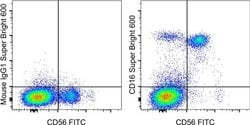Learn More
Invitrogen™ CD16 Monoclonal Antibody (eBioCB16 (CB16)), Super Bright™ 600, eBioscience™
Mouse Monoclonal Antibody
Supplier: Invitrogen™ 63016842

Description
Description: The eBioCB16 monoclonal antibody recognizes CD16 (Fc gamma RIII), the low-affinity receptor for IgG with an apparent molecular weight of 50-80 kDa. CD16 is represented by two similar genes, CD16A (Fc gamma RIIIA), which exists as a hetero-oligomeric polypeptide-anchored form in macrophages and NK cells and CD16B (Fc gamma RIIIB), which exists as a monomeric GPI-anchored form in neutrophils. Furthermore, there are two known polymorphisms of CD16B, NA-1 and NA-2. Individuals homozygous for NA-2 show a lower phagocytic capacity compared with NA-1. CD16 binds IgG in the form of immune complexes and shows preferential binding of IgG1 and IgG3 isotypes and minimal binding of IgG2 and IgG4. Upon IgG binding, both CD16 isoforms initiate signal transduction cascades that lead to a variety of responses including antibody-dependent cell-mediated cytotoxicity (ADCC), phagocytosis, degranulation, and proliferation. Applications Reported: This eBioCB16 (CB16) antibody has been reported for use in flow cytometric analysis. Applications Tested: This eBioCB16 (CB16) antibody has been pre-titrated and tested by flow cytometric analysis of normal human peripheral blood cells. This can be used at 5 μL (0.25 μg) per test. A test is defined as the amount (μg) of antibody that will stain a cell sample in a final volume of 100 μL. Cell number should be determined empirically but can range from 105 to 108 cells/test. Super Brig...
CD16, known as Fc gamma receptor III, exists in two distinct isoforms: Fc gamma RIIIA and Fc gamma RIIIB. These isoforms are encoded by the genes FCGR3A and FCGR3B, respectively, which are located on chromosome 1 and share a high degree of similarity. Fc gamma RIIIA is expressed as a polypeptide-anchored form on monocytes, macrophages, and lymphocytes such as natural killer (NK) cells, but not on T or B cells. This receptor recognizes the Fc portion of immunoglobulin G (IgG) and is involved in the clearance of immune complexes from circulation. Upon binding IgG, Fc gamma RIIIA activates signal transduction pathways that result in antibody-dependent cell-mediated cytotoxicity (ADCC), phagocytosis, cytokine release, and antigen presentation. Fc gamma RIIIB is expressed on polymorphonuclear neutrophils (PMN) as a glycosylphosphatidylinositol (GPI)-anchored form. It plays a role in similar immune functions, including cellular-mediated cytotoxicity and enhancement of virus infections. Mutations in the FCGR3A gene have been associated with Immunodeficiency 20 and linked to susceptibility to recurrent viral infections, systemic lupus erythematosus, and alloimmune neonatal neutropenia. Alternatively spliced transcript variants encoding different isoforms have been identified for this gene. Diseases associated with FCGR3A include Immunodeficiency 20 and Herpes Zoster.
Specifications
| CD16 | |
| Monoclonal | |
| 5 μL/Test | |
| PBS with BSA and 0.09% sodium azide; pH 7.2 | |
| O75015, P08637 | |
| FCGR3A, FCGR3B | |
| Affinity chromatography | |
| RUO | |
| 2214, 2215 | |
| 4°C, store in dark, DO NOT FREEZE! | |
| Liquid |
| Flow Cytometry | |
| eBioCB16 (CB16) | |
| Super Bright 600 | |
| FCGR3A | |
| 4833442P21Rik; CD16; CD16-2; CD16A; CD16a antigen; CD16b; CD32; CD32 receptor 2; CDw32; cytolytic trigger molecule G7; Fc fragment of IgG intermediate affinity IV receptor; Fc fragment of IgG low affinity IIIa receptor; Fc fragment of IgG receptor IIIa; Fc fragment of IgG receptor IIIb; Fc fragment of IgG, low affinity III, receptor for (CD16); Fc fragment of IgG, low affinity IIIa, receptor; Fc fragment of IgG, low affinity IIIa, receptor (CD16a); Fc fragment of IgG, low affinity IIIa, receptor for (CD16); Fc fragment of IgG, low affinity IIIa, receptor for (CD16); Fc fragment of IgG, low affinity III, receptor for (CD16); Fc fragment of IgG, low affinity IIIb, receptor (CD16b); Fc gamma receptor III; Fc gamma receptor IIIa; Fc gamma receptor III-A; Fc gamma receptor IIIb; Fc gamma RIIIa; Fc gammaRIV; Fc receptor, IgG, low affinity III; Fc receptor, IgG, low affinity IV; Fc receptor-like 3; Fcg receptor III; FCG2; FCG3; Fc-gamma receptor III-2 (CD 16); Fc-gamma receptor IIIb (CD 16); Fc-gamma receptor IIIb (CD16); Fc-gamma RII-b; Fc-gamma RII-c; fc-gamma RIII; Fc-gamma RIIIa; Fc-gamma RIII-alpha; fc-gamma RIIIb; fc-gamma RIII-beta; Fc-gamma-RIIb; Fc-gamma-RIIc; FcgammaRIII; FcgammaRIII a.1; FcgammaRIII a.2; FcgammaRIII a.3; FcgammaRIIIA; FcgammaRIV; FCGR2; FCGR2A; FCGR2B; FCGR2C; FCGR3; Fcgr3a; FCGR3B; Fcgr4; FCGRIII; FcgRIV; FcR-10; FcRII-b; FcRII-c; FcRIII; FCRIIIA; FCRIIIb; Fcrl3; IGFR3; IgG Fc gamma receptor III; igG Fc receptor III; IgG Fc receptor III-1; igG Fc receptor III-2; IMD20; immunoglobulin G Fc receptor III; LOC100911825; Low affinity immunoglobulin gamma Fc region receptor III; low affinity immunoglobulin gamma Fc region receptor III-A; Low affinity immunoglobulin gamma Fc region receptor III-B; low affinity immunoglobulin gamma Fc region receptor III-like; Low affinity immunoglobulin gamma Fc region receptor IV; neutrophil-specific antigen NA; RP11-5K23.1; transmembrane receptor FcgammaRIII-X | |
| Mouse | |
| 100 Tests | |
| Primary | |
| Human | |
| Antibody | |
| IgG1 κ |
Safety and Handling
The Fisher Scientific Encompass Program offers items which are not part of our distribution portfolio. These products typically do not have pictures or detailed descriptions. However, we are committed to improving your shopping experience. Please use the form below to provide feedback related to the content on this product.

